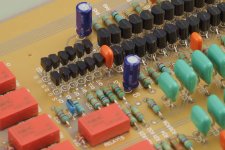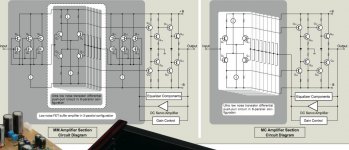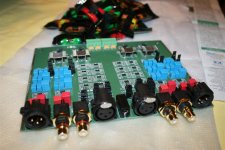yes, its the latest version. I admit being lazy, and bought the kit from pilgham audio. everything fine except a little mistake in the BOM (R24 and R25 appear twice, but with different values) and to my taste the jumpers JP1 and JP2 are very close to the JFET pins, making for difficult soldering....
but it all worked out, the boards are sitting on my desk waiting for the case... will post some pictures once finished.
but it all worked out, the boards are sitting on my desk waiting for the case... will post some pictures once finished.
I made a fully balanced phonoamp. It is the FPS that i described in Linear Audio Volume 0.
I whould call that the balanced MPP because up to that time it summed up my work on balanced phonos. It does not only have a balanced input but is balanced all the way to the ouput including the RIAA. I will look up my files if i can find the data. As far as i can remember the S/N is -77dB flat to 20kHz. RIAA is correct to more then 200kHz and distortion is extremely low. A single ended phono with the same amount of input devices whould have a somewhat better S/N of -80dB but more distortion and less imunity to common mode noise. In praxis the S/N advantage is less because the cartridge itselve produces Johnson noise. In case of my Lyra Titan i with ca.6 Ohm impedance the advantage is less then 2dB. To put that in perspective a phonostage based on the AD797 for example with a noise voltage of 1nV/qHz is 6dB noisier then the FPS and it is not balanced. Stages with the AD797 are described in the press as ultra low noise so now you know what i am talking about. The NE5534 workaround stage build with BF862 at the input would have around 1nV/qHz too but has the advantage that you can use it with MC and MM. Voltage Noise in that stage can be lowert too by paralleling more Fets. In the latest Accuphase stage i have seen as much as 16 in parallel. At ca. 0.3nV there is a natural boundary and more paralleling is not productive any more. The reasons why are described by Ovidiu Popa in Linear Audio Volume 1 at least for one popular topology.
I whould call that the balanced MPP because up to that time it summed up my work on balanced phonos. It does not only have a balanced input but is balanced all the way to the ouput including the RIAA. I will look up my files if i can find the data. As far as i can remember the S/N is -77dB flat to 20kHz. RIAA is correct to more then 200kHz and distortion is extremely low. A single ended phono with the same amount of input devices whould have a somewhat better S/N of -80dB but more distortion and less imunity to common mode noise. In praxis the S/N advantage is less because the cartridge itselve produces Johnson noise. In case of my Lyra Titan i with ca.6 Ohm impedance the advantage is less then 2dB. To put that in perspective a phonostage based on the AD797 for example with a noise voltage of 1nV/qHz is 6dB noisier then the FPS and it is not balanced. Stages with the AD797 are described in the press as ultra low noise so now you know what i am talking about. The NE5534 workaround stage build with BF862 at the input would have around 1nV/qHz too but has the advantage that you can use it with MC and MM. Voltage Noise in that stage can be lowert too by paralleling more Fets. In the latest Accuphase stage i have seen as much as 16 in parallel. At ca. 0.3nV there is a natural boundary and more paralleling is not productive any more. The reasons why are described by Ovidiu Popa in Linear Audio Volume 1 at least for one popular topology.
In the latest Accuphase stage i have seen as much as 16 in parallel.
Only three in parallel (K370) at the MC stage input (Q1 etc), bulk is complementary differential BJT.
Attachments
Last edited:
Here is the basic circuit of the FPS from Linear Audio 0. The actual circuit is a bit more alaborated with more Opamps in parallel to drive the feedback of the first stage and a diffential servo around the second stage. RIAA precision is better then plus-minus 0.1 dB without any odd values but with selection of the caps to 1%. Distortion is mostly burried in the noisefloor and when it comes out is less then 0.001% up to high frequencies. The kit that Pilgham provides does not have the balanced to unbalanced converter at the output. It was put in for simulation. So it is also balanced out.
Attachments
MC stage input

(memo note, think again before pushing enter button)
How do you mean that "flat to 20kHz"? Noise distribution should have to follow the EQ curve.... As far as i can remember the S/N is -77dB flat to 20kHz.
I'm also interested in fully balanced phono , that's why I have a raised a question to you in relation of measurments.
Here are my meausrements to compare with yours.
Hagerman inverse riaa + Phono is connected on Left CH, Right channel is simple looked back to show the capability of the system.
Attachments
This are really excellent results. I whould be interested to see the circuit diagram. "Flat" noise of my stage was calculated by Sigurd Ruschkowski in Microcap so i have to ask him how he did that. To get the real measure of a phonostage i connect the cartridge to the stage and play a reference tone at 1kHz 5cm/sec from a record (red ). The Lyra Olympos cartridge i used has around 0.3mV output at that speed and an impedance of a bit less then 6 Ohm that adds to the noise as Johnson noise. I compare that to the noise of the stage with the arm lifted ( light blue and the other channel yellow). See an example of a single ended Fet stage with 4 x
2SK170 and 4 x 2SJ74. The blue line is the output of the Olympos to pink noise.
2SK170 and 4 x 2SJ74. The blue line is the output of the Olympos to pink noise.
Attachments
Some missing details
Measurements made by a modified E-MU 1212, so the fullscale (0dB) is approx. +18dBu.
The Hagerman type inverse riaa was implemented (twice) fully differentialy, so its exit appears as a ~120R @ 60dB atten for phono. It isn't too optimal setup for a 4 pair of AD797.
The phono stage had in 60dB gain.
With 0R input termintaion and +66dB gain the calculated RTI noise is 31nV in audio band.
Measurements made by a modified E-MU 1212, so the fullscale (0dB) is approx. +18dBu.
The Hagerman type inverse riaa was implemented (twice) fully differentialy, so its exit appears as a ~120R @ 60dB atten for phono. It isn't too optimal setup for a 4 pair of AD797.
The phono stage had in 60dB gain.
With 0R input termintaion and +66dB gain the calculated RTI noise is 31nV in audio band.
I build balanced stages with the AD797 too. After 20 years it is till one of the lowest distortion and noise amps around. How did you modify the Soundcard ? I use an E-Mu 0202.
Does the Hagerman implement the Neumann "pole" and is this the reason for the rising response towards 20kHz ? I usually do not implement the Neumann. Most MC cartridges are a little hot up there anyway and are voiced with a standart RIAA.
Does the Hagerman implement the Neumann "pole" and is this the reason for the rising response towards 20kHz ? I usually do not implement the Neumann. Most MC cartridges are a little hot up there anyway and are voiced with a standart RIAA.



